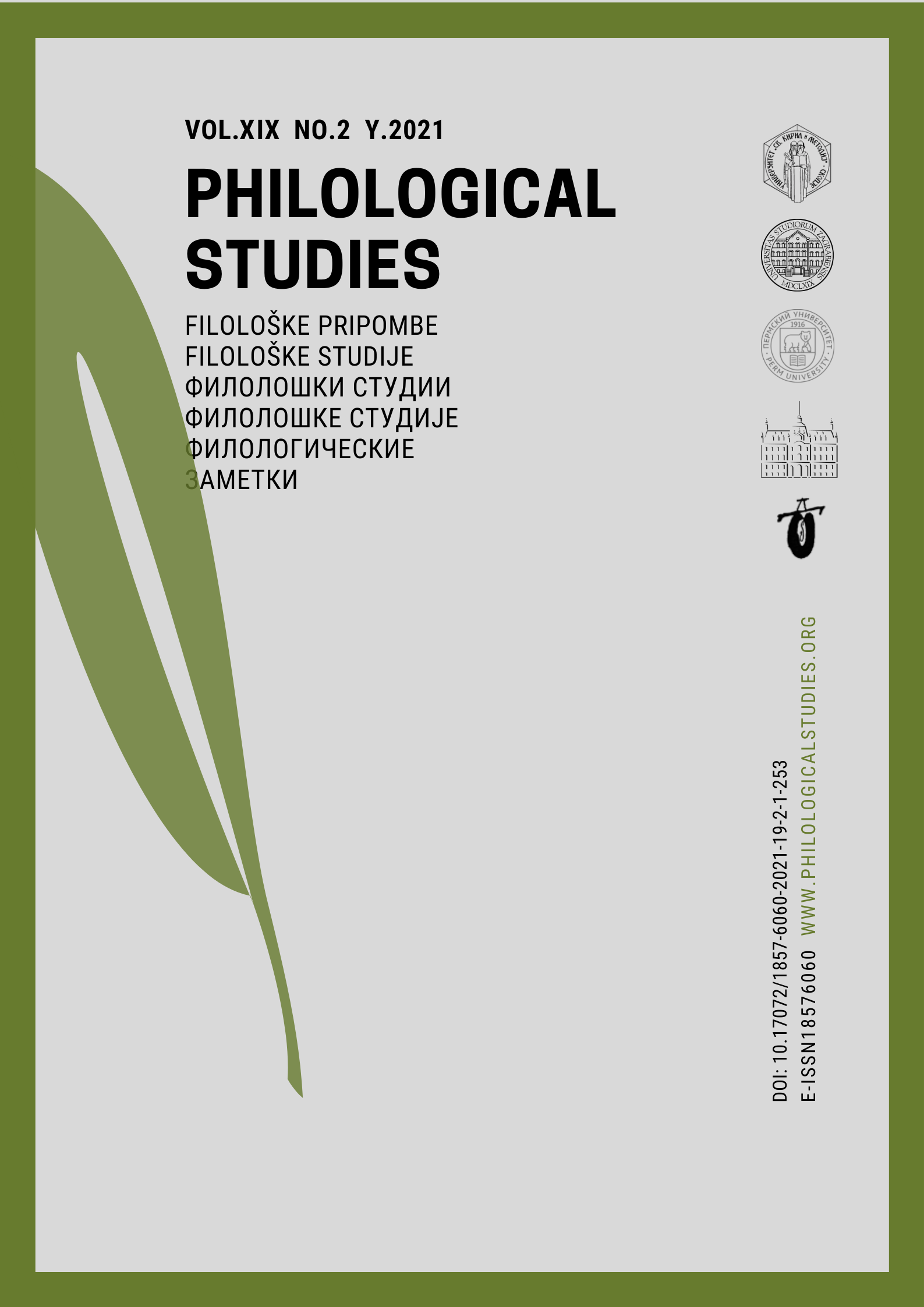THE LITERARY TRADITION IN THE NOVEL “THE FAMILY” BY NINA FEDOROVA
Клучни зборови:
literature of the Russian abroad, literary centricity, Nina Fedorova, Goncharov, novel, literary tradition, poeticsАпстракт
The article discusses the specifics and features of the functioning of the literary tradition in the novel “The Family” by Nina Fedorova in the context of phenomenon of literary centricity, which characterizes works of Russian émigré literati. In the work by the writer of the Russian abroad, there are many similarities with the novel by I.A. Goncharov “The Cliff”: at the level of the chronotope structure, individual images (the image of the Grandmother) and the image system as a whole, plot moves, motives, as well as stylistic devices. “The Family” is characterized by literary-centricity, it reproduces the atmosphere of the Russian manor culture and the topic of the Russian manor novel, the structural elements of Russian prose of the second half of the 19th century. Following the tradition allows the writer to keep in touch with Russian classical literature and Russian culture as a whole. At the same time, the recognition of the literary tradition reinforces the tragic register in the novel dedicated to the life of Russian emigrants of the first wave. The paper also considers some features of the poetics of the novel “The Family”: the role of symbolism in the figurative system of the work, the specifics of its spatial-temporal organization, the peculiarities of using metaphors, some characteristics of the narrative.
Превземања
Преземања
Објавено
Издание
Секција
Дозвола
Авторите во списанието претставуваат оригинални дела врз основа на резултатите од сопственото истражување. Лицата кои дале значителен придонес во трудот се наведуваат како коавтори. Заедно со статијата, авторите (и коавторите, доколку ги има) треба да достават пополнет образец за пријава на трудот (Paper Submission Form), со кој се потврдува согласноста на авторот за објавување на трудот.
Списанието прифаќа научни трудови кои претходно не биле објавени. Не се прифаќаат трудови кои во голема мера ги повторуваат претходно објавените трудови на авторите. Повторувањето подразбира и компилација – текст составен од фрагменти од објавена монографија или голем број на претходно објавени статии. Плагијатот не е дозволен, како и прекумерното цитирање на туѓи трудови (една третина или повеќе од целиот труд). Сите цитати, цитирани извадоци и материјали мора да имаат цитирани автори и извори. Ако уделот на туѓиот труд е преголем, се препорачува да се скратат цитатите и да се зголеми обемот на оригиналниот текст.
Авторот треба да ги има сите потребни дозволи за користење на позајмените материјали и материјалите на други автори што ги користи во својот труд (илустрации и слично). Авторот гарантира дека статијата не содржи информации што не подлежат на објавување во отворен печат, вклучувајќи ги и оние што содржат или претставуваат доверливи информации.
Во списокот на литературата се вклучени само делата цитирани во трудот, како и линковите за страниците и изворите од кои е цитирано доколку станува збор за извори од интернет. На авторот му се препорачува да ги наведе во текстот изворите на финансиска поддршка на спроведените истражувања и стипендиите, доколку ги имало. Исто така, може да се изрази благодарност и до колегите кои придонеле или помогнале околу работата на текстот, а кои не се коавтори.
Со доставувањето на ракописот и образецот на апликација до редакцијата, авторот официјално се согласува со објавувањето на неговиот труд во „Филолошки студии“. Авторите се носители на авторски права и ги задржуваат сите права за објавување и користење на статијата. Авторите имаат право да ја повлечат статијата во кое било време до моментот на објавување на сајтот, со тоа што претходно за тоа, по писмен пат, треба да ја известат редакцијата на списанието.
Статиите се објавуваат бесплатно. Содржината е достапна под лиценцијата Creative Commons Attribution-Noncommercial-No Derivative Works 3.0 Unported License.
Издавачка Етика
Редакција
Сите трудови доставени до Редакцијата ги читаат прво нејзините членови и соработници за да се утврди дали се однесуваат тие на релевантната проблематика и дали одговараат на форматот на списанието. Редакцијата на „Филолошки студии“ гарантира дека разгледувањето на доставените трудови и нивните рецензии не зависат од: комерцијални интереси, пол, националност, верски убедувања, политички ставови и други фактори. Единствениот критериум при изборот е академското ниво на трудот.
Во зависност од рецензијата, статијата може веднаш да се прати за објавување, да биде отфрлена или испратена до авторот за измена и за доработка. Во случај на несогласување со забелешките на рецензентот, авторот има право да ги оправда своите ставови. Доколку од рецензентите се добиени контрадикторни мислења, текстот се упатува на трет рецензент или конечната одлука се заснова на гласање на членовите на Редакцијата, по одделното разгледување.
Рецензенти
Статиите испратени до Редакцијата минуваат процес на двојно анонимно рецензирање. Имињата на рецензентите не треба да му бидат познати на авторот на статијата и обратно. Рокот за рецензирање е три-четири седмици. Рецензентите можат да бидат членови на Редакцијата и автори на списанието што објавувале претходно во него. Онаму каде што е неопходно, за рецензенти се назначуваат специјалисти од други: организации, градови и земји.
Рецензентите треба да бидат специјалисти за предметно-тематската област на која се однесува статијата. Редакцијата треба да спречи каков било судир на интереси во врска со дадениот научен труд и со неговиот автор.
Рецензентот е должен да им обрне внимание на членовите на Редакцијата за секоја суштинска сличност или поистоветување меѓу ракописот што се рецензира и која било друга публикација што му е позната. Рецензентот, исто така, е должен да го држи во тајност трудот што му е доверен, да не го пренесува на трети лица ракописот што му е доверен нему за рецензија и пред објавувањето на публикацијата да не ги објавува информациите содржани во него.
Рецензентите треба да дадат објективна, непристрасна и аргументирана процена на трудот. Забелешките треба да бидат формулирани коректно, така што оценувањето на трудот се однесува само на текстот на статијата и на неговата содржина. Рецензијата треба да биде напишана добронамерно, а наведените забелешки имаат за цел да им помогнат на авторите да ги коригираат утврдените недостатоци и да ја подобрат статијата пред да биде објавена таа на веб-страницата на издавачот и пред да биде достапна за пошироката публика.


